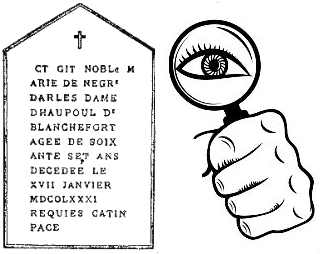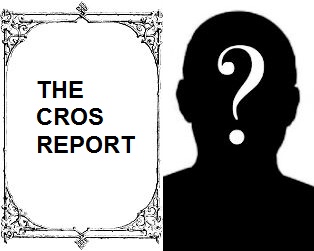|
A Critical Review Paul Smith 20 January 2016
Rennes-le-Château conspiracy theorists love making-up unreliable claims about the gravestone of Marie de Negri d'Ables and its “unusual inscription”. In fact such mistakes on gravestone inscriptions – that can perhaps even be deliberate – can also be found on other gravestones and are nothing unusual in the region of Rennes-le-Château. Henry Lincoln himself showed other similar examples in one of his videos – and French researchers some years ago discovered another gravestone that bore the word “catin” on its inscription. 
The inscription on the gravestone of Marie de Negri d'Ables, Countess Hautpoul-Blanchefort only becomes relevant if you are a believer in the “mystery” of Rennes-le-Château to begin with and if you want to drag the “mystery” back to beyond Bérenger Saunière – and to ignore the fact that his trafficking in masses activities (the source of his wealth) only took off in a big way in 1896 (when Saunière was 44 years old), and when his superiors in Carcassonne began receiving reports from various people about his activities. 
The alleged “Cros Report” that refers to this gravestone didn't exist before the mid-1960s and it was most likely produced after the publication of the book L'Or de Rennes by Gérard de Sède in 1967. There is absolutely no evidence that the alleged “Cros Report” existed in 1958. Noël Corbu never mentioned the “Cros Report” on a Frances-Inter Radio Programme of 1962 and nobody can show from the transcript of Corbu's Radio interview that he did. Robert Charroux never asked Noël Corbu any questions about the alleged “Cros Report” on that Radio interview – like he would have done had it really existed and Corbu was reading from it in his hands. It was only Patrick Mensior's imagination that was responsible for this unjustified and unsourced claim (Patrick Mensior published the full transcript of the 1962 interview in “Emission radiophonique enregistrée en juillet 1962 avec la participation de Noël Corbu,” pages 24-40, in his magazine Parle-moi de Rennes-le-Château, N° 2, 2005).

Nobody knows what happened to the “Mort épée” gravestone if it ever existed in the first place. The infra-red photographs of it that were published in Deloux and Bretigny's book Rennes-le-Château, capitale secrète de l'histoire de France (Paris: Editions Atlas, 1982) are obvious poor fakes. |